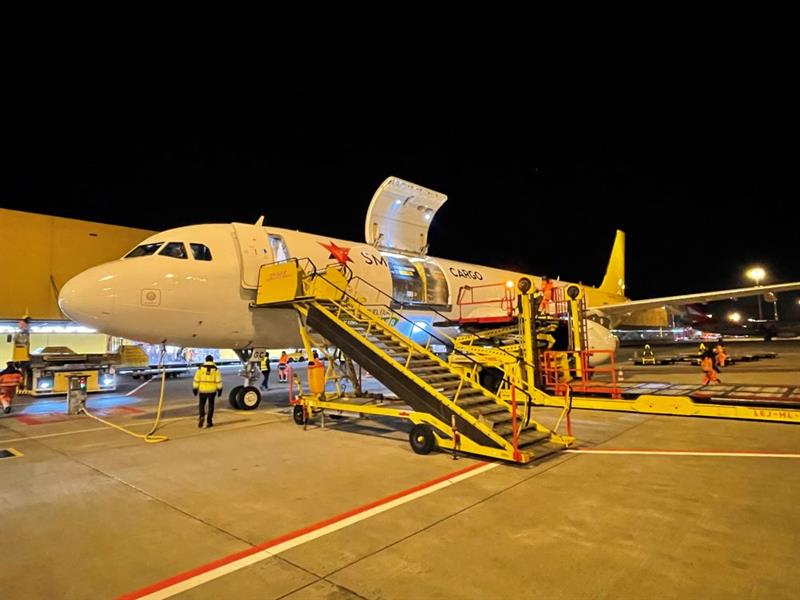
Back in March 2020, when no one knew what was hitting them, cargo took an immediate hit as borders closed and the world went into lockdown.
Passengers were unable to fly but the cargo sector sprung into action to keep supply chains moving.
Cargo capacity was in high demand but there was limited supply. Freighters were in strong demand with airlines and lessors placing orders for factory built aircraft and converted freighters.
Conversion companies were taking large orders and now have backlogs which will keep them busy for the next few years, even though cargo demand is falling as economic activity slows down and major economies cope with the cost-of-living crisis.
The Boeing Converted Freighter programme is one of the services offered by Boeing Global Services, and it is converting 737-800s and 767-300s at a healthy rate.
More than 100 737-800BCFs have been delivered with more than 250 orders and commitments, and the 767-300BCF has received more than 100 orders and commitments with more than 60 deliveries.
The 767-300BCF programme was launched in 2005 when All Nippon Airways ordered three aircraft, with the first delivery in June 2008. It can carry up to 51.6 tonnes and fly up to 3,345 nautical miles. It has a total cargo volume of 15,724 cubic feet and is suited to serving the general and express cargo markets.
The 737-800BCF programme was launched in 2016 with the first aircraft getting delivered to GECAS (now part of AerCap) in April 2018, operated by West Atlantic. Serving express cargo on domestic and short-haul routes, it can carry up to 23.9 tonnes and has a range of 2,025 nautical miles.
Boeing has several conversion sites across Asia, the Americas and in Europe, including a second line at its MRO facility at London’s Gatwick Airport. This year it will open the first of two conversion lines at KF Aerospace in Canada.
Boeing says, “When we increase conversion capacity, we also take into account the fact that long-term demand for freighter conversions is strong. Any future decisions to adjust conversion capacity will be based on these factors.”
Converting a passenger aircraft into a freighter gives it a useful second life, with Boeing commenting, “Our passenger-to-freighter programmes provide airlines an excellent way to extend the economic life of an airplane through use as a dedicated cargo freighter, providing operators with an economical way to replace less efficient, older-generation freighters.”
Compared to previous generation aircraft, the 737-800BCF uses 20% less fuel and cuts CO2 emissions by 20% per tonne.
Even before the pandemic, Boeing was seeing strong growth for express shipments to support e-commerce operations and this will remain a key driver in emerging and mature markets, though not the only driver.
Boeing says, “Our Boeing Converted Freighters play a central role in the growing e-commerce and express cargo markets, delivering the capability, reliability and efficiency our customers need today and into the future.”
Boeing does not publicly share its orders and redeliveries but says demand is strong, saying, “With our strong backlogs for both the 737-800BCF and 767-300BCF, we are focused on delivering on our customer commitments.”

Demand stays high
In 2022, Precision Aircraft Solutions redelivered 17 aircraft and is expecting to deliver more than 30 this year. The Boeing 757 is its preferred product, with 15 deliveries in 2022, and it delivered two A321s with a third following in January this year. With a large order book, Precision expects to stay busy for at least the next 18 to 24 months.
Describing demand as above average, Precision says, “The demand for freighters during Covid appeared faster than conversion providers can convert them. It demonstrates how volatile the cargo market is, and is never in-line with the aircraft life cycle. Most conversion providers will remain full for the next 2-3 years.”
Precision converts 757-200s and A321-200s, with the 757-200 programme winding down and orders extending for the next 12-15 months. Suitable conversion feedstock and engines are dwindling and many good aircraft are still in passenger fleets.
Precision says, “With nearly identical cargo volume and using 20% less fuel, the A321-200PCF fits well in a 757-200 role. Of course, the 757 offers unprecedented payload and range, which will remain important to some but not all users need or use it.”
Belly capacity is returning but the pandemic proved that people should not take that capacity for granted. The pandemic created a new respect for converted freighters with operators, lessors and investors considering them as part of their future planning.
The arrival of more 737s on the market may create overcrowding but Precision says, “For now, the demand for the A321 remains high as there have only been 18 redelivered globally. The market is hungry for more.”
Cargo demand has fallen back to 2019 levels and capacity is returning to the market but demand for freighters remains strong, with orders taken within the last two years waiting to be fulfilled. The pandemic meant older freighters, which should not be flying or were brought out of retirement, are still in the air and will need to be replaced.
Precision says, “Even if growth were to slow down, the replacement cycle still exists and ESG issues will continue to drive the world into greener and more efficient aircraft as time goes on.”
This article was published in the February issue of Air Logistics International, click here to read more.
